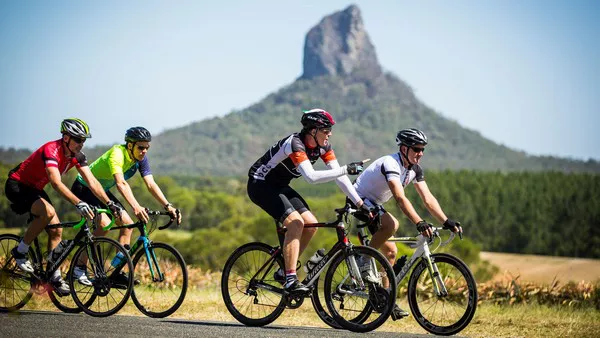Cycling is a great way to stay fit, explore the outdoors, and commute in an eco-friendly manner. However, what you wear while cycling can significantly impact your comfort, safety, and performance. This article will explore what you should avoid wearing when cycling, explaining why certain clothing choices might not be the best for your rides.
1. Cotton Clothing
Cotton clothing is a common choice for many people due to its comfort and breathability. However, it is not ideal for cycling. Cotton absorbs sweat and holds onto it, making your clothes heavy and damp. This can lead to chafing and discomfort, especially on long rides. Instead, opt for moisture-wicking fabrics designed to keep you dry.
2. Loose or Baggy Clothing
Loose or baggy clothing can be dangerous while cycling. It can get caught in the bike’s moving parts, such as the chain or gears, leading to accidents. Tight-fitting clothing reduces wind resistance and ensures that nothing gets snagged. Cycling-specific apparel is designed to fit closely to the body for this reason.
3. Heavy or Bulky Clothing
Heavy or bulky clothing can restrict your movement and make it harder to pedal efficiently. It can also cause you to overheat, especially in warmer weather. Lightweight and breathable fabrics are better choices. Layering with thin, thermal garments is effective in colder weather.
4. Clothing with Seams in the Wrong Places
Seams in the wrong places can cause friction and discomfort. This is particularly true for long rides where repetitive motion can lead to chafing. Cycling shorts and jerseys are designed with flat seams placed in areas that reduce the risk of chafing.
5. Non-Breathable Fabrics
Non-breathable fabrics trap heat and moisture against your skin, making you feel hot and sweaty. This can be particularly uncomfortable in warm weather. Look for fabrics that offer good ventilation and moisture management to stay comfortable on your rides.
6. No Visibility Clothing
Wearing clothing that makes you hard to see can be a significant safety risk. Brightly colored clothing or clothing with reflective elements increases your visibility to motorists, especially in low-light conditions. Avoid dark or dull colors that blend into the background.
7. Flip Flops or Sandals
Flip flops or sandals are not suitable for cycling. They do not provide the necessary support or protection for your feet. Your feet could slip off the pedals, or you could injure your toes if they come into contact with the ground or the bike’s parts. Closed-toe shoes with a stiff sole are recommended.
8. Clothing Without Padding
Cycling involves sitting on a saddle for extended periods. Clothing without padding can lead to discomfort and saddle sores. Padded cycling shorts are designed to provide extra cushioning and reduce pressure on sensitive areas.
See Also: The 5 Best Harness for Hiking
9. Tight Jeans or Non-Stretch Pants
Tight jeans or non-stretch pants restrict your range of motion. This can make pedaling difficult and uncomfortable. They can also cause chafing and do not offer the breathability needed for cycling. Stretchy, breathable fabrics are much more suitable.
10. Incorrectly Layered Clothing
Incorrectly layered clothing can make it difficult to regulate your body temperature. In colder weather, it is important to layer correctly to stay warm without overheating. Start with a moisture-wicking base layer, add an insulating layer, and top with a windproof or waterproof outer layer if needed.
11. Too Many Accessories
Wearing too many accessories, such as scarves, jewelry, or loose belts, can be hazardous. These items can get caught in the bike’s moving parts or distract you while riding. Keep accessories to a minimum and ensure they are securely fastened.
12. Improper Cycling Shoes
Wearing shoes that are not designed for cycling can affect your performance and safety. Proper cycling shoes are designed to fit snugly and have stiff soles that improve power transfer to the pedals. They also often have cleats that lock into the pedals for a more efficient ride.
13. No Helmet or Inadequate Headgear
Not wearing a helmet or wearing an inadequate helmet is a major safety risk. A proper cycling helmet is designed to protect your head in the event of a fall or collision. Ensure your helmet fits well and meets safety standards.
14. Non-Specific Cycling Clothing
General athletic clothing may not offer the same benefits as cycling-specific clothing. Cycling clothing is designed with features such as pockets for storage, longer backs to cover you while bent over the handlebars, and silicone grips to keep everything in place.
15. Heavy Backpacks
Carrying a heavy backpack can strain your back and shoulders and throw off your balance. If you need to carry items, consider using a cycling-specific backpack that distributes weight evenly or using panniers attached to your bike.
Conclusion
Wearing the right clothing when cycling is crucial for comfort, safety, and performance. Avoiding cotton clothing, loose or baggy garments, heavy or bulky outfits, and non-breathable fabrics can make a big difference. Opt for brightly colored, visible clothing and ensure your footwear and helmet are appropriate for cycling. By making mindful clothing choices, you can enhance your cycling experience and stay safe on the road.

